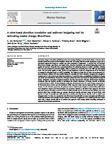A rules-based shoreface translation and sediment budgeting tool for estimating coastal change: ShoreTrans
| dc.contributor.author | McCarroll, Jak | |
| dc.contributor.author | Masselink, Gerd | |
| dc.contributor.author | Valiente, NG | |
| dc.contributor.author | Scott, Tim | |
| dc.contributor.author | Wiggins, Mark | |
| dc.contributor.author | Kirby, J-A | |
| dc.contributor.author | Mikhalenko, Natalia | |
| dc.date.accessioned | 2021-09-17T12:51:06Z | |
| dc.date.available | 2021-09-17T12:51:06Z | |
| dc.date.issued | 2021-05 | |
| dc.identifier.issn | 0025-3227 | |
| dc.identifier.issn | 1872-6151 | |
| dc.identifier.other | 106466 | |
| dc.identifier.uri | http://hdl.handle.net/10026.1/17827 | |
| dc.description.abstract |
Predicting change to shorelines globally presents an increasing challenge as sea level rise (SLR) accelerates. Many shoreline prediction models use the simplistic ‘Bruun rule’ for dealing with SLR profile translation, in-part due to alternative approaches being too complex and time-consuming to implement. To address this, we introduce ShoreTrans: a simple, rules-based, user-input driven, shoreface translation and sediment budgeting model, that applies the surveyed 2D-profile (not a parameterization), for estimating change to realistic coastlines, resulting from SLR and variations in sediment supply, while accounting for armouring, hard-rock cliffs and outcropping rocks. The tool can be applied to sand, gravel, rock and engineered coasts at a temporal scale of 10–100 years, accounting for shoreline trends as well as variability. The method accounts for: (1) dune encroachment/accretion; (2) barrier rollback; (3) non-erodible layers; (4) seawalls; (5) lower shoreface transport; (6) alongshore rotation; and (7) other sources and sinks. Uncertainty is accounted for using a probabilistic distribution for inputs and Monte Carlo simulations. We provide a first-pass assessment of two macrotidal UK embayments: Perranporth (sandy, dissipative, cross-shore dominant transport) and Start Bay (gravel, reflective, bi-directional alongshore dominant), then use idealised profiles to investigate the relative importance of forcing controls on shoreline recession and beach width. For the dissipative sandy site, the primary modes of coastal change are predicted to be short-term storm erosion and SLR translation while long-term trends may be important but are highly uncertain. For the reflective gravel site, the primary mode is multi-decadal longshore sediment flux, while short-term alongshore rotation and SLR translation are secondary. Relative to the ShoreTrans approach, the Bruun rule under-predicts shoreline recession in front of cliffs, seawalls and for low barriers that rollback, and over-predicts where large erodible dunes are present. ShoreTrans directly addresses change in beach width, with beaches in front of seawalls and cliffs predicted to shrink, such that narrow beaches (<50 m width) may disappear under 1-m SLR. As a standalone tool, ShoreTrans is transferable to many coast types and will provide coastal practitioners with a simple first-pass estimate of how the 2D appearance of a complex profile may change under SLR. A future benefit will be to combine this approach with existing hybrid modelling techniques to augment SLR translation predictions. | |
| dc.format.extent | 106466-106466 | |
| dc.language | en | |
| dc.language.iso | en | |
| dc.publisher | Elsevier | |
| dc.subject | Sea level rise | |
| dc.subject | Multi-decadal coastal evolution | |
| dc.subject | Shoreline modelling | |
| dc.subject | Bruun rule | |
| dc.title | A rules-based shoreface translation and sediment budgeting tool for estimating coastal change: ShoreTrans | |
| dc.type | journal-article | |
| dc.type | Journal Article | |
| plymouth.author-url | https://www.webofscience.com/api/gateway?GWVersion=2&SrcApp=PARTNER_APP&SrcAuth=LinksAMR&KeyUT=WOS:000640186100011&DestLinkType=FullRecord&DestApp=ALL_WOS&UsrCustomerID=11bb513d99f797142bcfeffcc58ea008 | |
| plymouth.volume | 435 | |
| plymouth.publication-status | Published | |
| plymouth.journal | Marine Geology | |
| dc.identifier.doi | 10.1016/j.margeo.2021.106466 | |
| plymouth.organisational-group | /Plymouth | |
| plymouth.organisational-group | /Plymouth/Faculty of Science and Engineering | |
| plymouth.organisational-group | /Plymouth/Faculty of Science and Engineering/School of Biological and Marine Sciences | |
| plymouth.organisational-group | /Plymouth/REF 2021 Researchers by UoA | |
| plymouth.organisational-group | /Plymouth/REF 2021 Researchers by UoA/UoA07 Earth Systems and Environmental Sciences | |
| plymouth.organisational-group | /Plymouth/Research Groups | |
| plymouth.organisational-group | /Plymouth/Research Groups/Marine Institute | |
| plymouth.organisational-group | /Plymouth/Users by role | |
| plymouth.organisational-group | /Plymouth/Users by role/Academics | |
| plymouth.organisational-group | /Plymouth/Users by role/Researchers in ResearchFish submission | |
| dcterms.dateAccepted | 2021-03-10 | |
| dc.rights.embargodate | 2021-9-18 | |
| dc.identifier.eissn | 1872-6151 | |
| dc.rights.embargoperiod | Not known | |
| rioxxterms.versionofrecord | 10.1016/j.margeo.2021.106466 | |
| rioxxterms.licenseref.uri | http://www.rioxx.net/licenses/all-rights-reserved | |
| rioxxterms.licenseref.startdate | 2021-05 | |
| rioxxterms.type | Journal Article/Review | |
| plymouth.funder | Impact of sequence of extreme storms during 2013/14 winter on southwest coast of England::NERC | |
| plymouth.funder | Impact of sequence of extreme storms during 2013/14 winter on southwest coast of England::NERC |


